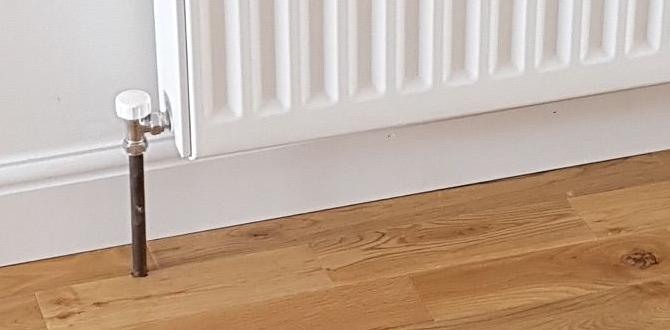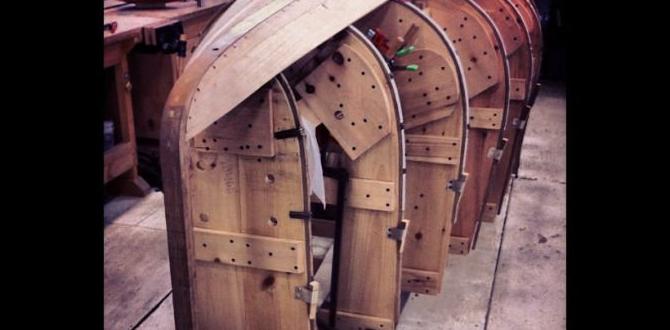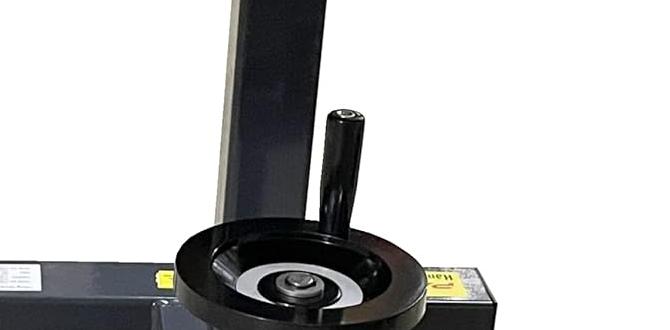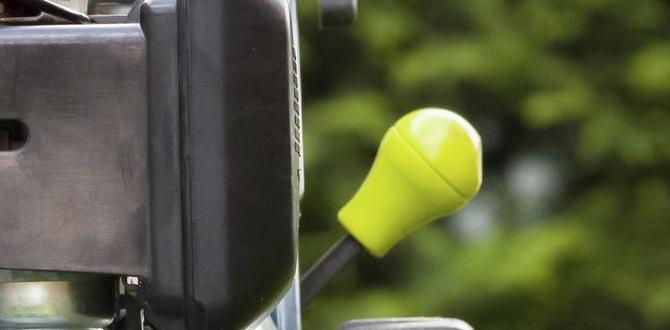Quick Summary
Effortlessly using a nailer for ceiling work is achievable with the right preparation, tool, and technique. This guide ensures a safe and efficient installation, making your DIY projects a success.
Working overhead can feel daunting, especially when it’s time to fasten materials to your ceiling. Many DIYers worry about fumbling with nails, dropping tools, or struggling to get a secure hold. But what if I told you there’s a smart, efficient way to tackle ceiling work with a nailer? It doesn’t have to be a wrestling match with gravity. With a bit of know-how and the right approach, you’ll be driving nails overhead with confidence and ease. This guide will walk you through everything from choosing the right nailer to executing each step safely and effectively. Get ready to transform your ceiling projects from frustrating challenges into satisfying accomplishments!
Table of Contents
Why Ceiling Work Can Be Tricky (And How a Nailer Helps!)
Let’s be honest, nobody enjoys holding a piece of drywall or trim overhead while trying to hammer in a nail. It’s awkward, tiring, and often results in missed shots, bent nails, or even a few bumps on the head. That’s where a nailer truly shines. A power nailer takes the manual labor out of driving fasteners, allowing you to secure materials quickly and accurately. Instead of one nail at a time, you’re using a tool that drives nails with a pneumatic push or an electric charge, saving you immense time and physical strain, especially when working above your head.
The key benefits of using a nailer for ceiling work include:
- Speed: Dramatically reduces the time needed to fasten materials.
- Efficiency: Drives nails precisely and powerfully, ensuring a strong hold.
- Reduced Fatigue: Minimizes the physical effort required, making the job less tiring.
- Accuracy: Helps achieve consistent results with properly seated nails.
- Safety: When used correctly, it can be safer than manual hammering in awkward overhead positions.
Choosing the Right Nailer for Ceiling Tasks
Not all nailers are created equal, and picking the right one for ceiling work is crucial. You’ll primarily be looking at two types that are well-suited for general fastening tasks common in ceiling installations like putting up drywall, wood paneling, or trim.
1. Pneumatic Nailers (Air Nailers)
These are often the workhorses for construction and heavy-duty DIY. They require an air compressor to operate.
- Pros:
- Powerful for driving larger nails.
- Lightweight in hand, as the compressor does the heavy lifting.
- Generally more affordable in the long run if you already have a compressor.
- Reliable and durable.
- Cons:
- Require an air compressor and hose, which adds bulk and limits maneuverability.
- Can be noisy.
- Initial investment in a compressor can be high.
When to Use for Ceilings:
Ideal for attaching wood subflooring that might be used as a substrate for ceilings, framing, or heavier wood paneling where significant holding power is needed.
2. Electric Nailers (Corded & Cordless)
These nailers use electricity for power, either from a wall outlet or a battery.
- Pros (Cordless):
- Extreme portability – no compressor or hose needed.
- Easy to maneuver in tight spaces or around obstacles.
- Quick to set up.
- Cons (Cordless):
- Can be heavier due to the battery pack.
- Battery life can be a limitation for long jobs.
- May have less power than pneumatic nailers for very dense materials.
- Higher initial cost.
- Pros (Corded):
- Consistent power without worrying about battery life.
- Generally lighter than cordless models.
- Often more affordable than cordless options.
- Cons (Corded):
- Tethered by a power cord, which can be a tripping hazard and restrict movement, especially overhead.
When to Use for Ceilings:
Cordless electric nailers are fantastic for installing drywall, decorative trim, lattice, or lighter wood paneling on ceilings. The freedom from cords is a huge advantage when working overhead.
Specific Nailer Types for Common Ceiling Tasks
For most DIY ceiling projects, you’ll likely encounter these specific nailer types:
A. Finish Nailers
Use for installing trim, molding, and decorative wood elements. They drive slimmer nails that leave smaller holes, making them ideal for visible work. For ceilings, this means elegant crown molding or decorative wood strips.
B. Brad Nailers
Similar to finish nailers but use even thinner, smaller nails (brads). Best for very delicate trim work, quarter-round, or thin decorative pieces. They offer less holding power but are excellent for aesthetic details.
C. Framing Nailers
While heavy-duty, they are usually overkill for typical ceiling finishing. However, if you’re doing structural work like framing a ceiling joist system before installing sheathing, this would be your tool. For most homeowners, this isn’t the nailer for finishing touches.
D. Roofing Nailers
Specifically designed for attaching roofing shingles. While not for interior ceiling work, they highlight how specialized nailers can be. For interior ceilings, stick to finish or framing nailers.
Recommendation for most ceiling DIY: A cordless 18-gauge or 16-gauge finish nailer is often the most versatile and user-friendly option for tasks like installing trim, paneling, or even some types of lightweight ceiling tiles.
Essential Safety Gear and Preparations
Before you even think about firing a nail overhead, safety is paramount. Working above yourself comes with unique risks, and proper gear can prevent serious injuries. Think of it as your personal safety shield!
Safety Gear Checklist:
- Safety Glasses: Non-negotiable! Always protect your eyes from flying debris, nail fragments, or accidental misfires. Full coverage goggles are even better for overhead work.
- Hearing Protection: Nailers can be loud. Earplugs or earmuffs will protect your hearing over time.
- Work Gloves: Protect your hands from splinters, sharp edges, and providing a better grip.
- Sturdy Footwear: Closed-toe, slip-resistant shoes are essential. You might be standing on a ladder or scaffolding.
- Helmet (Optional but Recommended): If you’re working in a construction zone or just want extra protection against falling objects, a hard hat is a good idea.
Pre-Work Preparations:
- Read Your Nailer’s Manual: Every nailer is different. Familiarize yourself with its specific operation, safety features, and maintenance.
- Inspect Your Nailer: Check for any damage, loose parts, or obstructions in the magazine or air connections (if pneumatic).
- Clear the Work Area: Remove any furniture, tools, or clutter from beneath where you’ll be working. This prevents tripping hazards and protects your belongings from falling debris.
- Secure Your Work Surface: Whether you’re using a stepladder, extension ladder, or scaffolding, ensure it’s stable and properly positioned. Check that it’s rated for your weight and the tasks. For more on ladder safety, check out resources from OSHA.
- Check Your Power Source: For cordless, ensure your batteries are charged. For corded electric, use a heavy-duty extension cord suitable for outdoor use (even indoors, it’s tougher). For pneumatic, ensure your compressor is set to the correct PSI for your nailer.
- Load Nails Carefully: Follow your nailer’s instructions for loading nails. Ensure they are the correct size and type for your tool and project.
Taking these preliminary steps ensures a smooth and safe working environment, allowing you to focus on the task at hand, not on potential hazards.
Step-by-Step Guide: How to Use Your Nailer in Ceiling Work
Now that you’re geared up and prepared, let’s get to the exciting part – using the nailer!
Step 1: Choose Your Fasteners
Selecting the right nail size and type is critical for both holding power and appearance. For ceiling work:
- Drywall: Usually attached with screws, but if using a nailer for specific types of ceiling panels or furring strips behind drywall, consult the panel manufacturer’s recommendations.
- Wood Paneling/Beadboard: 16-gauge or 18-gauge finish nails are common. Choose a length that will go through your paneling and securely into the ceiling joist or furring strips (typically at least 1 inch into the joist).
- Trim (Crown Molding, etc.): A 16-gauge finish nailer is ideal. Use nails long enough to penetrate the trim and at least 1/2 to 3/4 of an inch into the framing. If attaching directly to drywall without hitting studs, you might need anchors or a different fastening method.
Always check the specifications for your nailer to ensure it accepts the nails you intend to use.
Step 2: Prepare Your Nailer
This is where you get the tool ready to fire.
For Pneumatic Nailers:
- Ensure the air compressor is running and set to the recommended pressure (usually found on the nailer or in its manual – generally between 70-120 PSI).
- Connect the air hose securely to the nailer’s air inlet.
- Load the correct nails into the magazine. Slide the feeder mechanism back, place the nails in a strip, and release the feeder to hold them in place. Ensure the nails are not bent or damaged and are facing the correct direction for your tool.
- Make sure the safety contact tip (the part that touches the surface) is clear.
For Cordless Electric Nailers:
- Ensure your battery is fully charged and properly inserted into the tool.
- Load the correct nails into the magazine. Similar to pneumatic tools, there’s a feeder mechanism that you slide back.
- Check that the safety contact tip is clear.
Step 3: Position Yourself Safely
This is crucial for overhead work.
- Stable Ladder/Platform: Ensure your ladder or scaffolding is on a level, firm surface. If using an extension ladder, have someone foot it or secure it at the top if possible.
- Comfortable Reach: Position yourself so you can comfortably reach the area you need to nail without overextending.
- Clear Line of Fire: Make sure there’s nothing directly above or behind where you’ll be firing nails.
Step 4: The Firing Technique
This is the moment of truth. Using the nailer correctly prevents misfires and provides a clean finish.
- Engage the Safety Contact Tip: Press the nose of the nailer firmly against the surface where you want to drive the nail. This safety feature prevents the nailer from firing unless it’s in contact.
- Aim: Ensure the nail will go into the desired spot, ideally into the solid framing or joist behind your material.
- Squeeze the Trigger: Once firmly pressed and aimed, squeeze the trigger. The nail should fire cleanly.
- Withdraw the Nailer: Slightly lift the nailer off the surface after each shot.
Pro Tip: For trim or molding, you might want to use a nailer with a “contact actuation” or “bump fire” mode. This allows you to press the safety tip against the wood and then bump it forward slightly to drive a nail, which is faster for repetitive work. Always be extra careful with this mode, as it’s easier to accidentally fire unintended nails.
Step 5: Checking Your Work
After each nail, or every few nails, take a moment to check.
- Nail Depth: Is the nail head sitting flush with the surface, slightly proud (sticking out), or sunk too deep? Most nailers have an adjustable depth setting. You want the nail head flush or very slightly below the surface for trim, so it can be painted over easily. For structural connections, ensure it’s driven fully.
- Material Security: Does the material feel firmly attached?
- Placement: Are the nails in the right spot?
If a nail isn’t set correctly, and if your nailer has a nail-set mode, you can gently tap it to seat it further. If it’s too deep, you might need to adjust the depth setting and potentially remove and re-drive the nail, or fill the hole.
Step 6: Troubleshooting Common Issues
Even experienced users run into snags. Here are a few common ceiling work problems and solutions:
- Doubled Nailing: Two nails fired too close together, or one slightly off and another next to it. This usually just requires filling the extra hole.
- Nail Jam: If nails jam in the magazine or mechanism, unplug or disconnect the air supply, remove the battery, and consult your manual for clearing instructions. Never force it.
- Nails Not Driving Fully:
- Check air pressure (pneumatic).
- Ensure the correct nail size is being used.
- Battery might be low (cordless).
- The surface might be too hard/dense.
- Adjust depth settings.
- Nails Bending: Often caused by hitting knots in wood or driving nails at an angle. Ensure you’re aiming straight and loading correct nails.
Step 7: Finishing Touches
Once all your fastening is done:
- Fill Nail Holes: Use wood filler or putty that matches your material’s color. For painted surfaces, a lightweight spackle works well.
- Sand (if necessary): Once filler is dry, lightly sand the filled areas smooth.
- Clean Up: Dispose of empty nail boxes, debris, and any spilled materials.
When to Consider an Expert or Alternative Methods
While nailers are fantastic tools, they aren’t always the perfect solution for every ceiling task.
Situations to Reconsider Using a Nailer:
- Very Old or Fragile Ceilings: Lath and plaster ceilings or very brittle materials might crack or break under the force of a nailer.
- Exposed Electrical Wiring or Plumbing: If you are unsure of what lies behind the ceiling surface, using a nailer could be dangerous. Always check for obstructions. Tools like stud finders with AC detection can help, but caution is advised. For example, a Zircon stud finder can help detect wires and pipes.
- Extremely Difficult Angles: Sometimes, the angle required to hit a nailer’s safety contact effectively is impossible to achieve safely and effectively.
- Delicate Materials: While brad nailers are fine, very thin or brittle materials might still be damaged.
Alternative Fastening Methods:
- Screws: For drywall and many other applications, screws provide a stronger hold and are less likely to cause blowout than nails. You can use a powerful drill/driver for this.
- Adhesives: Construction adhesives are excellent for bonding panels or trim, especially in conjunction with minimal fasteners.
- Specialty Fasteners: Depending on the material, specific clips, hangers, or anchors might be required.
If you’re ever in doubt about the safety or suitability of using a nailer, it’s always best to consult a professional or opt for a more appropriate fastening method.
Nailer Maintenance for Longevity
To ensure your nailer performs reliably for years to come, a little maintenance goes a long way. Think of it as giving your tool a spa day!
Regular Cleaning:
- After each use, wipe down the exterior of the nailer with a damp cloth to remove dust and debris.
- Periodically, clean out the nail magazine to remove any metal shavings or old glue from nails.
Lubrication:
- Pneumatic Nailers: Most pneumatic tools require a drop or two of specialized pneumatic tool oil in the air inlet fitting before each use. Check your manual for the correct type and schedule. Using the




